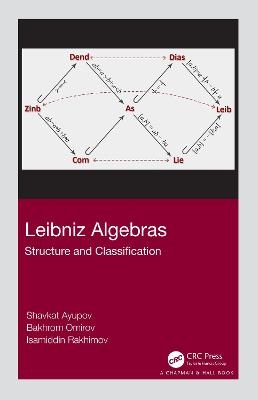
Leibniz Algebras
Chapman & Hall/CRC (Verlag)
978-0-367-35481-7 (ISBN)
Leibniz algebra is generalization of Lie algebras. These algebras preserve a unique property of Lie algebras that the right multiplication operators are derivations.
Leibniz Algebras: Structure and Classification is designed to introduce the reader to the theory of Leibniz algebras.
Leibniz algebra is the generalization of Lie algebras. These algebras preserve a unique property of Lie algebras that the right multiplication operators are derivations. They first appeared in papers of A.M Blokh in the 1960s, under the name D-algebras, emphasizing their close relationship with derivations. The theory of D-algebras did not get as thorough an examination as it deserved immediately after its introduction. Later, the same algebras were introduced in 1993 by Jean-Louis Loday , who called them Leibniz algebras due to the identity they satisfy. The main motivation for the introduction of Leibniz algebras was to study the periodicity phenomena in algebraic K-theory.
Nowadays, the theory of Leibniz algebras is one of the more actively developing areas of modern algebra. Along with (co)homological, structural and classification results on Leibniz algebras, some papers with various applications of the Leibniz algebras also appear now. However, the focus of this book is mainly on the classification problems of Leibniz algebras. Particularly, the authors propose a method of classification of a subclass of Leibniz algebras based on algebraic invariants. The method is applicable in the Lie algebras case as well.
Features:
Provides a systematic exposition of the theory of Leibniz algebras and recent results on Leibniz algebras
Suitable for final year bachelor's students, master's students and PhD students going into research in the structural theory of finite-dimensional algebras, particularly, Lie and Leibniz algebras
Covers important and more general parts of the structural theory of Leibniz algebras that are not addressed in other texts
Shavkat Ayupov Shavkat Ayupov is the Director of the Institute of Mathematics of Uzbekistan Academy of Sciences, Professor at the National University of Uzbekistan and, Doctor of Sciences in Physics and Mathematics and fellow of TWAS (The Academy of Sciences for the Developing World). His research interests include Functional analysis, Algebra and Topology. Sh. Ayupov is recipient of several international titles and awards and his main research deals with the study of Operator algebras, Jordan and Lie structures on von Neumann algebras, Derivations and automorphisms on operator algebras, Structure theory of Leibniz algebras and Superalgebras and other non-associative algebras. Sh. Ayupov is an organizer of CIMPA research school workshops and International Conferences on Nonassociative Algebras and Applications and on Operator Algebras and Quantum Probability. He has spoken at numerous plenary sessions and has been invited to numerous talks in various international conferences and workshops. Sh. Ayupov is also the Chief Editor of the Uzbek Mathematical Journal and has authored 4 textbooks, 5 monographs, and more than 150 research papers which have been published in several international journals. Bakhrom Omirov Bakhrom Omirov is Professor at the National University of Uzbekistan, Doctor of Sciences in Physics and Mathematics, and research fellow at the Institute of Mathematics of the Uzbekistan Academy of Sciences. His research interests include Non associative algebras, Lie (super)algebras, Leibniz (super)algebras, n-Leibniz algebras, structure theory of algebras, p-adic analysis, evolution algebras and their applications. B. Omirov has received several local and international awards. He is currently leading several international research projects and collaborations and has been invited as a speaker to many workshops and universities abroad. He is also authored more than 100 research papers in high impact international journals. Isamiddin Rakhimov Isamiddin Rakhimov is Professor at the Universiti Technology MARA (UiTM), Doctor of Sciences in Physics and Mathematics, and research fellow at the Institute for Mathematical Research (INSPEM), Universiti Putra Malaysia. His research interests focus on the theory of finite-dimensional algebras and its applications. He has been invited to give speak in few international conferences and workshops. I. Rakhimov received his Ph.D. degree in Algebra from the Sankt Petersburg University of Russia. He has organized several international mathematical events and is on the Editorial Board of a few international journals. He has also authored 1 textbook, 2 monographs and more than 70 scientific papers published in international cited journals.
1. INTRODUCTION. 1.1. ALGEBRAS. 1.2. ASSOCIATIVE ALGEBRAS. 1.3. LIE ALGEBRAS. 1.4. LODAY ALGEBRAS. 2. STRUCTURE OF LEIBNIZ ALGEBRAS. 2.1. SOME PROPERTIES OF LEIBNIZ ALGEBRAS. 2.2. NILPOTENT AND SOLVABLE LEIBNIZ ALGEBRAS. 2.3. ON LEVI’S THEOREM FOR LEIBNIZ ALGEBRAS. 2.4. SEMISIMPLE LEIBNIZ ALGEBRAS. 3. CLASSIFICATION PROBLEM IN LOW DIMENSIONS. 3.1. ALGEBRAIC CLASSIFICATION OF LOW-DIMENSIONAL. LEIBNIZ ALGEBRAS. 3.2. APPLICATION. 3.3. LOW-DIMENSIONAL NILPOTENT LEIBNIZ ALGEBRAS. 3.4. 4-DIMENSIONAL SOLVABLE LEIBNIZ ALGEBRAS. 3.5. RIGIDITY OF LIE AND LEIBNIZ ALGEBRAS. 3.6. LEIBNIZ COHOMOLOGY COMPUTATIONS. 3.7. A RIGID LEIBNIZ ALGEBRA WITH NON-TRIVIAL HL^2. 3.8. LIE-RIGIDITY VERSUS LEIBNIZ-RIGIDITY. 4. ON SOME CLASSES OF LEIBNIZ ALGEBRAS. 5. ISOMORPHISM CRITERIA FOR FILIFORM LEIBNIZ ALGEBRAS. 5.1. ON BASE CHANGES IN COMPLEX FILIFORM LEIBNIZ ALGEBRAS. 5.2. A CRITERION OF ISOMORPHISMS OF COMPLEX FILIFORM. NON-LIE LEIBNIZ ALGEBRAS.
6. CLASSIFICATION OF FILIFORM LEIBNIZ ALGEBRAS IN LOW DIMENSIONS. 6.1. ISOMORPHISM CRITERIA FOR THE FIRST CLASS. 6.2. CLASSIFICATION OF THE FIRST CLASS IN LOW DIMENSIONS. 6.3. ISOMORPHISM CRITERIA FOR THE SECOND CLASS. 6.4. CLASSIFICATION OF THE SECOND CLASS IN LOW DIMENSIONS. 6.5. SIMPLIFICATIONS AND NOTATIONS IN THE THIRD CLASS. 6.6. CLASSIFICATION IN DIMENSION FIVE. 6.7 CLASSIFICATION IN DIMENSION SIX.
| Erscheinungsdatum | 26.11.2019 |
|---|---|
| Zusatzinfo | 4 Tables, black and white; 6 Illustrations, black and white |
| Sprache | englisch |
| Maße | 156 x 234 mm |
| Gewicht | 585 g |
| Themenwelt | Mathematik / Informatik ► Mathematik ► Algebra |
| Mathematik / Informatik ► Mathematik ► Arithmetik / Zahlentheorie | |
| ISBN-10 | 0-367-35481-0 / 0367354810 |
| ISBN-13 | 978-0-367-35481-7 / 9780367354817 |
| Zustand | Neuware |
| Haben Sie eine Frage zum Produkt? |
aus dem Bereich


